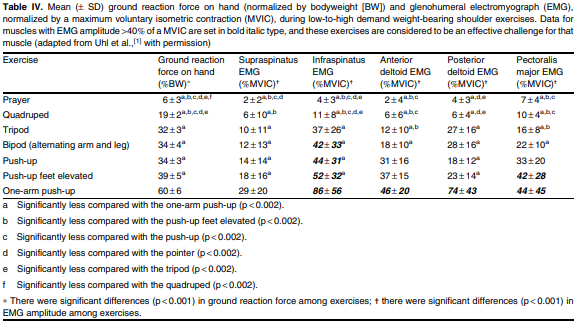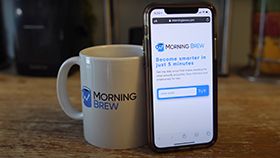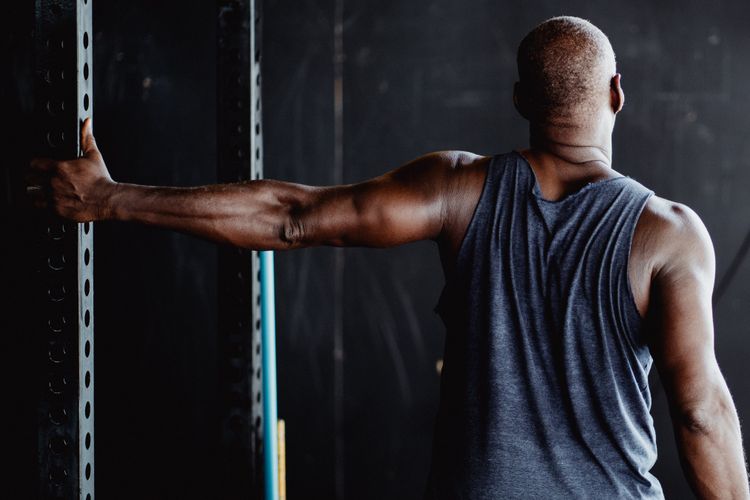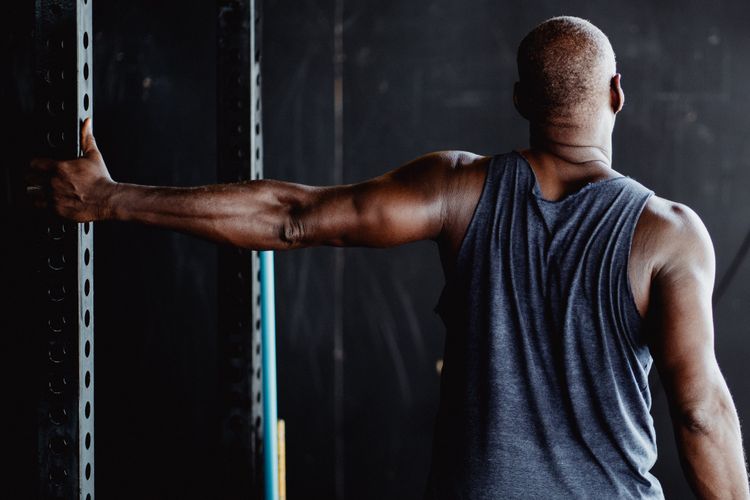PT Crab Issue 148 - Muscle Up

Apparently, I'm just into muscles right now. And today I'm into modifying muscles, how we tweak them to do ever so slightly different things. We're going to look into the effects of tweaks on the hip and shoulders, with two hip-based items and one about the shoulders. Hopefully I'll be providing you little tips to help focus on exactly the muscle you want. Since y'all are freeloaders (which is totally fine, btw) you'll just be receiving the intense, shoulder one.
With that, let's dive in!
What are your shoulder muscles doing?
The Gist - This is a long piece and it's an old article, but boy is a goodie. This one breaks down rotator cuff muscle activation patterns while using therabands or weights in different positions. It's pretty much exactly what I'm thinking about as my patients do some standing external rotation with a towel under their arms. This paper is complex and has TONS of data so I can't get into everything, obvs. But what I can do is point out some of what they tracked and make the rest available to you, so that's what I'm going to do. Also, this was a systematic review, so this date is all combined and statisticalled and stuff like that to put it in this form. K, let's go.
- ER - Their fantastic table of external rotation breaks down the different levels of activation of these muscles in different positions. For example, did you know that standing ER at 15 degress abduction with a towel roll activates the posterior deltoid to about 31% of maximum (at a 10 rep max level of weight) while activating infraspinatus to 50%. Meanwhile prone ER at 90 degrees of abduction activates the posterior deltoid to 79% while infraspinatus stays at 50% and middle deltoid steps up from 11% to 55%? Crazy, right? That's about 1/10th of the information from one table. And the tables are really well designed. In Tell Me More, below, I'll take you through one so you can do this on your own.
- Serratus - Another table compares UT, MT, LT, and Serratus across a myriad of exercises normalized to 5 rep max weights. In these, serratus preferentially activates during a D1 diagonal flexion pattern, reaching 100% of maximal isometric contraction, while UT gets to 66%, MT to 21% and LT to 39%. But if you want to keep serratus and LT turned up while turning down UT, check out our old friend, prone ER at 90 degrees of abduction. That's where serratus is activated to 57% of maximum, LT to 79%, and UT to just 20%. That's gold Jerry, gold!
Here's where I need to point out a couple of things. 1) These studies were done on healthy people without shoulder injuries, so this doesn't necessarily hold true for someone with a lot of UT substitution with elevation, for example, and 2) this is a systematic review, which is great, but that means it's lacking some details from the studies, like exact exercise instructions, cueing, and the like. I mean, we could read all the papers to find out, but ain't nobody got time for that.
Ain't nobody got time for me to verbally summarize a bunch of tables either, so head on down to the next section where I'll bring in a table and teach you to break it down so you can skim the paper for better exercise ideas without actually reading the thing.
Oh, last thing, if you feel squidgy skimming the paper, like you're not supposed to do that and should be judging its methodological quality or something, first, stop feeling like that. That's not your job. You job is to treat your patients and try to do the best you can. Trust the journal editors to get it right, within reason, obviously. And secondly, if you feel that way you probably shouldn't be reading the Crab since you're only getting a third-hand view of everything. So jump in there, skim the paper for the tables and the tables only, and enjoy a nice glass of wine on the patio after work because you were able to finish writing up your last eval and didn't spend half an hour beating a research paper to death with a rock and and a half-assed understanding of the evidence-based practice course you took 6 years ago and didn't pay attention to anyway because the professor sucked. Okay? Anyway, let's go on.
Tell Me More -

This is a table. Good thing I'm here to explain that, huh? It's a table from here: https://link.springer.com/article/10.2165/00007256-200939080-00004 and we're going to break it down.
Let's go through table IV so you can learn something and apply it to reading this paper, if you want to read this paper. Start with the caption - Mean ground reaction force on hand and EMG normalised by MVIC. I'm going to assume you know what all of those mean except MVIC. That's maximal voluntary isometric contraction, AKA the way you calibrate EMG by having someone squeeze that muscle as hard as they can to set a (theoretical) 100% level. After that's set, all measurements are a percentage of it. The ground reaction force on hand part isn't super important to me, but it may be for you depending on the patient's tolerance to loads through their hands.
For the data actually in the table, let's go exercise first. I didn't actually know what the prayer exercise is, but presume that it's a position similar to a traditional Muslim prayer, where the head is lowered all the way to a mat. Reading each type of muscle to the right indicates that Supraspinatus is activated to 2% of max, Infra to 4%, Anterior and posterior deltoids to 4% and pec major to 7%. And boom, that's the table. I'm not going to get into the a,b,c,d,e, and f parts because they're complicated. The part that I care about is that there were indeed significant difference between the exercises, as you can see on the bottom there.
The data is this table is fairly straightforward due to the constant increases of muscle activation as you go down the table. Makes sense, since the exercises are getting harder and harder. On a table like this, I'm going to check out and big jumps or gaps between numbers or places where the trends reverse, since that's probably where the most interesting information is going to be. Like the different between a one-arm pushup and a feet elevated pushup. That's a 34% activation difference for infraspinatus and a 51% difference for posterior deltoid. That's huge! And yes, I know that your patients aren't doing one-arm pushups, but this is just a learning exercise.
Now that we've broken that table down together, you should be empowered to go look at the other 10ish tables yourself. Seriously, it's such a wealth of information. I love it.
Paper? It right here.
Just like research, news doesn’t have to suck.

If you want to keep up with news the way you keep up with research, you need Morning Brew. This daily newsletter covers the latest news in a fun, funny, and engaging way. There's a reason over 2.6 million people start their day with Morning Brew— the daily email that delivers the latest news from Wall Street to Silicon Valley. News doesn't have to be dry and dense...make your mornings more enjoyable, for free with Morning Brew. Check it out here

This isn’t actually another research study.
The Gist - Really, it’s not. Nor is it an ad. What it is is a really interesting piece about lumbar muscle size change in space. Because astronauts. I’m not going to dig into it both because I’m tired and because I don’t think it’s going to help you in clinic. But hey, if you work with astronauts, lmk! If you ever want to be a PT at the South Pole, that’s run via Rice University, jsyk. They won’t let you go if you’re a student, but pros can apply. Did you know it’s actually easier to go to space than to the South Pole? I hope you didn’t because that’s not true. But it’s just plausible enough to make you think and that’s fun.
Anyway, here’s the astronaut thing.
And that’s our week! If I seem slap happy it’s because I’m writing this on a plane and planes are a weird place to work. Thanks again for being a supporter. I really appreciate you. I know you do it for you, but I feel like you do it for me, and research shows that the best relationships are ones where both partners feel like they’re getting the better end of the deal, so I guess we have a good relationship.
Love you XOXO,
Luke






Comments
Want to leave a comment and discuss this with your fellow PTs? Join PT Crab and get summarized PT research in your inbox, every week.